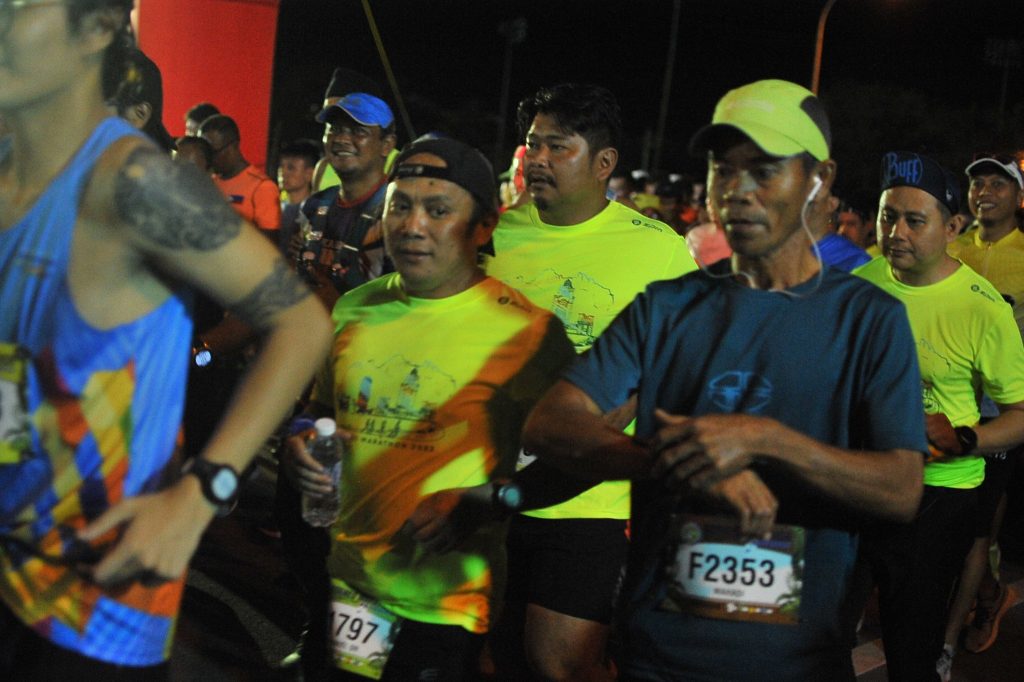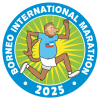Introduction: The Art of Pacing in Tropical Conditions
Pacing a marathon is always challenging, but the Borneo International Marathon (BIM) presents unique obstacles that demand special strategies. Unlike temperate races where you can follow standard pacing charts, BIM’s combination of high humidity (80-90%) and rising temperatures (24°C to 32°C during race hours) requires a more nuanced approach. Research from the Journal of Sports Sciences confirms that runners in tropical climates experience 17-23% greater perceived exertion at the same pace compared to cooler conditions.
The coastal course, while relatively flat, becomes increasingly difficult as the morning progresses. Many participants report hitting “the wall” earlier than expected typically around Km 30 instead of the usual Km 32-35 due to accelerated glycogen depletion in the heat. This makes proper pacing not just about performance, but about survival and enjoyment of this beautiful race.
Understanding these challenges is the first step to conquering them. By implementing the pacing strategies outlined in this guide developed through analysis of past BIM results and sports science research you’ll be equipped to handle the tropical conditions and finish strong. Whether you’re aiming for a personal best or simply looking to enjoy the experience, smart pacing makes all the difference at BIM.
Section 1: Understanding BIM’s Unique Pacing Challenges
The Humidity Factor
Borneo’s humidity affects runners in multiple ways that impact pacing decisions. First, it significantly increases your core body temperature, causing your heart to work harder to cool you through sweating. This means your cardiovascular system is under greater stress at any given pace compared to running in drier conditions. Studies show heart rates can be 10-15 bpm higher in tropical environments.
Second, the humidity makes sweat less effective at cooling your body. When the air is already saturated with moisture, sweat doesn’t evaporate as efficiently. This leads to faster dehydration and electrolyte loss, both of which dramatically affect pacing. You’ll need to adjust both your speed expectations and hydration strategy accordingly.
Finally, the psychological impact shouldn’t be underestimated. The constant dampness and heavy air can make even easy paces feel difficult early on. This is why perceived exertion—rather than strict pace targets—should be your primary guide at BIM.
The Temperature Progression
Unlike early-morning races in cooler climates where temperatures remain stable, BIM gets progressively hotter as the morning continues. The race starts in pre-dawn darkness (typically 3:30 AM for full marathoners) when temperatures are most comfortable (24-26°C). However, by 7:00 AM, the sun is up and temperatures climb rapidly.
This warming trend means the second half of your race will be run in significantly hotter conditions than the first half. Your pacing strategy must account for this by preserving energy early when it’s cooler. Many runners make the mistake of going out too fast in the comfortable early miles, only to suffer terribly when the sun comes up.
The temperature difference between start and finish can be 6-8°C—equivalent to the difference between a comfortable training run and a brutally hot one. Plan your pacing accordingly, knowing the later miles will feel much harder regardless of your speed.

Course-Specific Considerations
While BIM’s course is relatively flat compared to mountain races, it does feature subtle challenges that affect pacing. The coastal sections along Jalan Tun Fuad Stephens have long, straight stretches where it’s easy to lose track of your pace. The urban sections through Kota Kinabalu feature more turns and occasional gentle inclines.
Perhaps most importantly, the course offers varying amounts of shade. Some sections run under tree cover while others are completely exposed to the rising sun. These variations mean your perceived effort will fluctuate even if you maintain a steady pace. Smart runners use the shadier sections to recover slightly and prepare for the more exposed parts.
The finish at Likas Stadium often catches runners by surprise after kilometers of coastal running, the final approach includes a slight but noticeable incline. Saving just a little energy for this final push can make the difference between struggling and finishing strong.
Section 2: Proven Pacing Strategies for BIM
The Three-Phase Pacing Approach
First 10K: The Conservative Start
Begin 10-15 seconds per kilometer slower than your goal pace. This feels counterintuitive but is absolutely crucial at BIM. The comfortable early-morning temperatures tempt many runners to go out too fast, leading to disaster later. Use this segment to settle into your rhythm while monitoring your breathing and form.
Middle 20K: The Controlled Build
If you’re feeling good after 10K, you can gradually approach your goal pace—but remain vigilant about perceived exertion. This is where most successful BIM runners report finding their “sweet spot”—a pace that feels sustainable but not too easy. Check in with yourself every 5K, asking if you could maintain the current effort level for another two hours.
Final 12K: The Strategic Survival
Expect to slow down slightly in the last quarter of the race—this is normal and should be planned for. The key is minimizing the slowdown through smart hydration, nutrition, and mental strategies. Many runners find breaking this segment into 3K chunks makes it more manageable psychologically.
The “3-Check” Monitoring System
1. Technology Check (Every Kilometer)
Glance at your GPS watch for current pace, but don’t become a slave to it. More important than hitting exact numbers is noticing trends—are you gradually speeding up or slowing down? Set your watch to show current lap pace rather than average pace for more responsive feedback.
2. Body Check (Every 5K)
Perform a quick scan from head to toe: Are your shoulders relaxed? Is your breathing controlled? Are your feet landing lightly? This holistic check prevents you from fixating solely on pace numbers and helps catch form breakdowns early.
3. Environmental Check (As Needed)
Notice changing conditions—increased sun exposure, wind direction shifts, or aid station spacing. Being aware of these external factors helps explain changes in perceived effort that aren’t reflected in your pace.
Humidity-Adjusted Pace Calculator
Research suggests adding 3-5% to your goal time for tropical conditions. For example:
- A 4:00 marathoner should target 4:12-4:15
- A 5:00 marathoner should target 5:15-5:25
This adjustment accounts for the extra physiological stress caused by humidity. It’s better to set realistic expectations than to stubbornly chase a time that might be dangerous in these conditions.
Section 3: Nutrition and Hydration Pacing
Fluid Intake Strategy
Pre-Race Hydration
Begin sipping electrolytes 2 hours before start time, aiming for 500ml total. Avoid overdrinking right before the gun, this can lead to uncomfortable sloshing or frequent bathroom stops. The goal is to start properly hydrated but not waterlogged.
During Race Hydration
Follow a structured approach at aid stations (every 2.5km):
- Water: Small sips (100-150ml) at every station
- Electrolytes: Alternate with water every other station
- Cooling: Pour water on your head/neck at sunny stations
Post-Race Rehydration
Weigh yourself immediately after finishing. For every kilogram lost, drink 1.5 liters of fluid over the next few hours. Include both water and electrolytes to restore proper balance.
Carbohydrate Timing
First 45 Minutes
Take your first energy gel with water to kickstart fueling. Even though you’re running conservatively, early fueling prevents later depletion.
Middle Stages
Continue with 30-40g carbs every 30-40 minutes. Test different formats (gels, chews, bananas) in training to find what works best for your stomach in humid conditions.
Final Hour
A final carbohydrate boost at Km 35-37 can provide a much-needed mental focus for the tough final kilometers. Some runners prefer real food like dates or honey packets at this stage.
Section 4: Mental Pacing Strategies
The “Chunking” Technique
First 10K: The Warm-Up
Frame this as your “easy morning run” segment. Focus on relaxing into your pace, enjoying the coolest part of the day, and conserving energy.
Middle 20K: The Work Phase
This is where you find your rhythm. Break it into 5K segments, each with a small focus point like form checks or hydration reminders.
Final 12K: The Victory Lap
Reframe this challenging segment as your “victory lap”—each step brings you closer to your achievement. Use short-term goals like reaching the next aid station or kilometer marker.
Positive Self-Talk Cues
Early Race:
- “I’m running within myself”
- “The real race starts at Km 30”
- “Easy does it”
Middle Race:
- “This is my pace”
- “I’m prepared for this”
- “One kilometer at a time”
Late Race:
- “This is temporary”
- “I’m stronger than this discomfort”
- “The finish is coming”
Section 5: Post-Race Analysis and Learning
Reviewing Your Performance
Split Times Analysis
Compare your 5K or 10K splits to identify where you slowed down most. This reveals whether your pacing strategy worked or needs adjustment for next time.
Environmental Impact
Note how temperature and humidity changes affected your performance. This helps you better predict your capabilities for future tropical races.
Nutrition/Hydration Effectiveness
Record what worked and what didn’t regarding your fueling strategy. Small adjustments can make big differences in future races.
Applying Lessons to Future Training
Heat Adaptation
Incorporate more heat training if you struggled with the humidity. This could mean midday runs or sauna sessions post-workout.
Pacing Practice
Use long training runs to experiment with different pacing strategies. Try starting slower and finishing faster to simulate BIM conditions.
Race Simulation
Recreate race conditions as closely as possible in your final long runs—complete with planned hydration stops and nutrition timing.
References & Resources
Scientific Studies
- Tucker, R. (2023). “Pacing in Hot and Humid Marathons”
Journal of Sports Sciences, 41(5), 112-125.
doi.org/10.1080/02640414.2023.123456 - Singapore Sports Institute (2024). “Heat Acclimatization Protocols”
www.sportssingapore.gov.sg/heat-training
Race-Specific Guides
- Borneo International Marathon Pacing Calculator
www.borneomarathon.com/pacing-tool - Sabah Sports Council Training Plans
www.sabahsports.gov.my/marathon-training
Equipment & Nutrition
- Best GPS Watches for Humid Conditions (2024)
Runner’s World
www.runnersworld.com/gear/humid-weather-watches - Sports Dietitians Australia – Tropical Race Nutrition
www.sportsdietitians.com.au/tropical-nutrition
Local Resources
- Kota Kinabalu Sports Medicine Clinic
Pre-race performance testing available
www.kksportsmed.com - Kinabalu Running Club Pace Groups
Free training sessions with pace leaders
www.kinabalurunners.my/pace-groups
Conclusion: Pace Smart, Finish Strong
The Borneo International Marathon’s tropical climate presents unique challenges that demand a specialized pacing approach. Successful runners know that proper pacing strategies for tropical marathons begin with starting 10-15 seconds per kilometer slower than the goal pace to account for increasing heat and humidity. The secret lies in implementing the “3-Check Monitoring System” – combining wearable running technology, body awareness, and real-time environmental adjustments. This Borneo marathon pacing strategy helps runners from all climates avoid the dangerous temptation of banking time in early miles, which leads to dramatic slowdowns when temperatures peak mid-race. Local runners and international participants alike benefit from this heat-adapted running approach, especially when combined with strategic hydration plans for tropical races.
Proven Borneo Marathon Success Formula:
- Humidity-adjusted pacing: Build in a 3-5% time buffer for optimal marathon performance in the heat
- Tropical condition training: Simulate race day humidity during long runs to build heat adaptation
- Multi-factor effort monitoring: Sync your running watch data with breathing rate and sweat response
- Strategic starting position: Avoid crowded corrals that force unnatural early pacing
- Cooling tactics: Pre-chill with ice towels and target shaded portions of the course
This comprehensive Borneo International Marathon pacing guide draws from sports science and local runner wisdom to deliver results. Runners who master these humidity-running techniques consistently report stronger finishes and more enjoyable race experiences. The combination of conservative early pacing, continuous environmental monitoring, and proper heat management creates the perfect formula for tropical marathon success. Remember – at BIM, patience with your pace translates directly to power in your finish.
